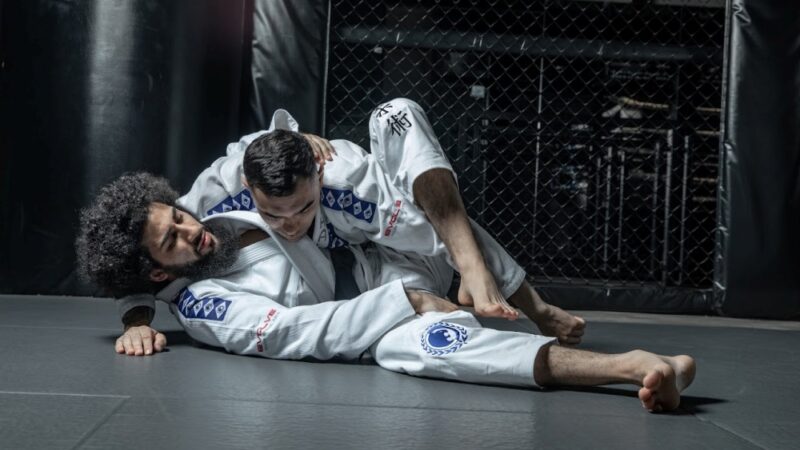Guest post by Evolve MMA, Asia’s premier championship brand for martial arts. It has the most number of World Champions on the planet. Named as the #1 ranked martial arts organization in Asia by CNN, Yahoo! Sports, FOX Sports, Evolve MMA is the top rated BJJ gym in Singapore.
Have you ever experienced in one of your BJJ classes where, after relentlessly passing the guard of a stronger training partner, he or she somehow still manages to effortlessly push you off the side control and regain their guard? Worry not. Today, we will talk about how you can maintain a dominant side control.
What Is Side Control?
The side control is one of the most dominant positions in grappling that allows you to control and submit your opponents. It happens when an athlete lays perpendicularly on top of his opponent, denying them the ability to control their legs, thus making the athlete on top free to perform movements.
The side control is only achieved after passing the opponent’s guard. After the guard pass, as the opportunities arise, the athlete may decide whether or not to transit to the side control or directly to the mount.
Kesa Gatame
Judo is known for its variation of side control, which is known as the kesa gatame or scarf hold. Unlike the usual side control in Jiu-Jitsu where the athlete on top is sprawling or kneeling, along with an underhook or a cross face placing pressure on the opponent, the kesa gatame, focuses more on controlling the head and arm. It uses one knee to block the opponent’s shoulder, and the other leg as a base while the body lies on the floating rib of the opponent.
Beginners usually struggle to maintain tight side control. As a result, they often find themselves easily getting reversed or swept during transitions. Ideally, tight side control is maintained by keeping a chest-to-chest contact, so you can easily follow the movements of your opponent, along with a heavy hip, and a constant threat to submit. It is also crucial to keep your knee close to the hip of the opponent so you can easily block or anticipate his attempts to escape.
The side control may be a favorite for bigger and stronger grapplers, but this doesn’t mean that smaller grapplers can’t apply this controlling position effectively as well. For smaller grapplers, it may be hard to pin down larger and stronger opponents from the side control, That is why it is crucial to incorporate side control flow drills to get used to changing positions.
Similar to any fundamental technique, every grappler should know how to maintain and move around the side control. Here 6 ways to help maintain and create dominant side control opportunities.
1) Creating Pressure In Side Control
It is crucial to apply shoulder pressure with the cross face to create pressure in the side control. As shown in the video by Bernardo Faria, the weight of the body must be directly on the opponent’s face, along with the shoulder pressure. The shoulder pressure blocks the movements of the opponent’s trapped arm, denying them any chance to create space or escape.
Bear in mind that the other hand that is not used must be posted on the mat and serve as a base. Likewise, keep the knees close to the hip of the opponent to secure the position. Once secured, the legs can then be sprawled adding more bodyweight pressure.
2) Maintaining Side Control Against Bigger Opponents
Smaller grapplers often experience a hard time maintaining side control against bigger and stronger opponents as they get overpowered easily. Chewy from Chewjitsu shares 3 tips for smaller guys whenever they get matched up against bigger opponents. Chewy mentioned that one thing to note, when matched against bigger grapplers, is to always flare their hand by performing a knee wipe, which aims to place the user’s knee on the opponent’s armpit.
Smaller grapplers can be more agile; thus, remember not to be too tight, as bigger guys can easily bridge and roll, reversing the position. It is essential to stay active by keeping the toes and knees engaged. Learning how to properly execute the kesa and reverse kesa gatame works well and opens up numerous transitions.
3) Side Control Flow Drill
Incorporating a flow drill before or after classes can never go wrong. An example of a side control drill is starting from the side control with an extended base and then going to the kesa gatame. After going to kesa, the athlete on top then goes back to the side control to reverse kesa gatame. Pinning the opponent’s far arm in the reverse kesa, the athlete on top then circles to the north-south position.
4) Transition From Side Control
BJJ World Champion Teco Shinzato from the Evolve Fight Team teaches the fundamental way to transition from side control to the mount. Starting from the side control, if the opponent tries to hip escape, the athlete should change to kesa gatame. After switching to kesa gatame, the athlete must revert to the side control, maintaining a tight position.
As mentioned earlier, beginners need to be familiarized with the kesa and reverse kesa gatame. After securing a tight side control, Teco instructed to move to reverse kesa gatame and back a little, to easily step over the opponent, which then transitions to the mount.
5) Solo Side Control Transition Drills
The video above from BJJ World Championship Silver Medalist Almiro Barros shows 5 side control transition drills which you can perform individually. The set of drills consists of the alternate knee on belly, sit-outs, reverse kesa gatame to mount, and knee on belly moving to the opposite side-to-side control.
All of these drills will help you with the idea of moving around the side control to maintain the dominant position.
6) Submission From Side Control
There are many submissions from the side control. One of them is the armbar. Almiro Barros demonstrates in the video how to perform a sneaky armbar from side control. It is performed by controlling the tricep of the opponent while putting a frame on their face, pushing the head away.
Once all set, Almiro then advises to step over the face and fall back to perform the armbar with the foot blocking the armpit.
Final Thoughts
Side control is one of the fundamental controlling positions a grappler must effectively learn in BJJ. Just like any position in BJJ, consistency is key. Keep on drilling the entries, escapes, and attacks. The more you practice, the more comfortable you become with side control, filtering out the loopholes in your game.

















